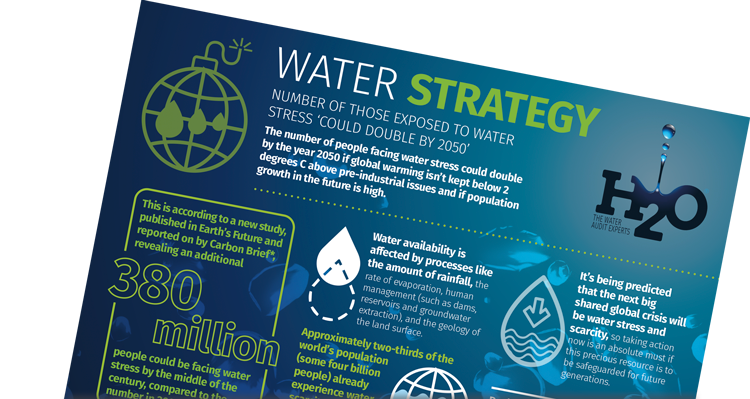Start saving
Water Strategy | Call us on: 0845 658 0948
Email us: info@h2obuildingservices.co.uk
Water strategy
Devising a corporate water strategy is a wise move for businesses of all shapes and sizes to take these days, as we’re faced with increasing problems where water availability is concerned thanks to climate change and a global growing population.
This will only serve to put even more pressure on our water resources – so the more businesses can do now the better if they’re to protect their own operations, which are sure to rely on water across some parts of the supply chain, if not all of it.
Luckily for companies these days, heightened awareness of water stress and security means that there is now all sorts of tech available to help them come up with an effective strategy – but the very first step to take is to accept that water is a central business issue and one that all companies should make a top priority in the future.
How to start your water strategy
The first step you need to take is to deepen your understanding of your water sources, consumption, use and discharge for all your business’s operations. This will help you set targets for the company and prioritise efficiency gains in this regard.
You’ll also need to carry out a risk assessment so you can gain valuable insights into the risks and opportunities posed by water availability before you can start to develop your own local water management plans.
From there, you can start to talk to your partners across your supply chain to find out more about your business’s water footprint and the impact that your company activities are having.
Sustainable water development: What to do
There are numerous ways in which businesses can start using water more sustainably, but the most obvious of these is perhaps conservation – using less water. This should form the heart of any corporate water strategy and there is immediate action that companies can take now to start making serious inroads in this regard.
Have a water audit carried out to identify and repair any leaks in existing water and plumbing systems, as well as reviewing your heating and air-conditioning systems so they can be made more efficient and help slash water wastage in this way.
Introducing energy-efficient infrastructure across your site can also help, so think about bringing in waterless urinals, water-efficient toilets and aerated faucets to reduce water use. You can also make excellent use of greywater systems that will collect rainfall for use in areas such as toilet flushing, laundry and vehicle washing.
Water monitoring is fast becoming one of the most popular ways to reduce water usage, as it can track the hourly flow of water over a period of ten years. If spikes in use are seen, this could indicate a problem like a leak, which can then be sorted out straight away instead of trickling water down the drain unnecessarily.
Why do we need to think sustainably?
Climate change is now undeniable and the way the world operates is changing – and businesses need to react accordingly. Climate predictions for this country show that we can expect to see more volatile weather in the future, which could result in greater water scarcity and more frequent flooding, which can lead to water contamination.
Global water scarcity will also have an impact in the UK, with climate change making other countries around the world less productive. This means we may have to start growing more of our own food, which will increase our national water demand.
Population growth will also see demand for water increase, particularly in places where it’s already scarce. More people will also see our sewerage and drainage needs increase, so the more that businesses and individuals do now to assess their own water usage and take action the better.
Call our expert consultancy team today on 0845 658 0948 alternatively, you can email us at info@h2obuildingservices.co.uk
Water strategy – H20 Building Services – Infographic
NUMBER OF THOSE EXPOSED TO WATER STRESS ‘COULD DOUBLE BY 2050’
The number of people facing water stress could double by the year 2050 if global warming isn’t kept below 2 degrees C above pre-industrial issues and if population growth in the future is high.
